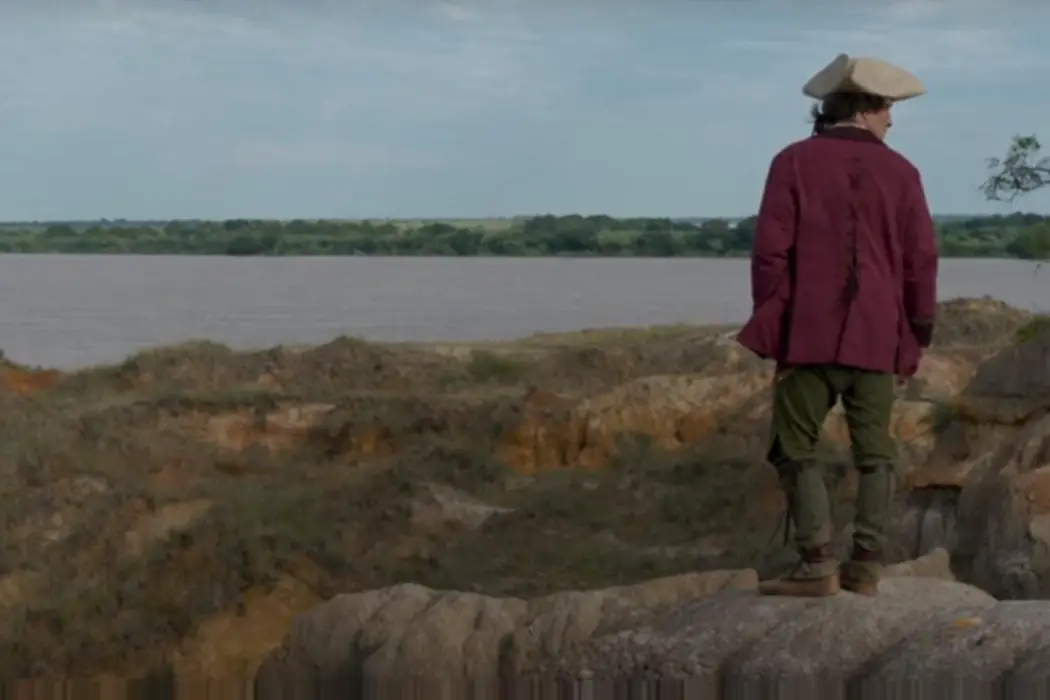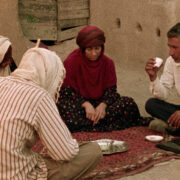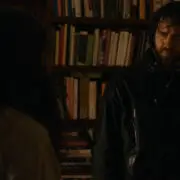ZAMA: New Beginnings, Old Myths

Midwesterner, movie lover, cinnamon enthusiast.
Zama, Argentine auteur Lucrecia Martel’s first film since 2008, opens contentiously. After caught spying on a group of indigenous women, a colonial figure we later come to know as Don Diego de Zama is yelled at, “Voyeur! Voyeur!” One of the women chases him down before he turns to confront her; he slaps her in the face — once compulsively, a second time deliberately. Wherever we are, there’s tension here.
Martel follows this cold opening with a metaphor about fish who spend their entire life treading water, moving to and fro near the water’s edge. While the water seeks to throw them ashore, the fish are “so attached to the element that repels them, devoting all their energies to remaining in place.”
New Territory
Not only is this the director’s first film in a decade, but it’s her first literary adaptation, bringing to the screen the 1956 novel by Argentinian Antonio De Benedetto. This comes after a triplet of uniquely spellbinding films that Martel made in the aughts loosely referred to as the Salta Trilogy. Together, they create a tapestry of women in contemporary Salta, Argentina, facing varying levels of frustration.

Zama is a period film about a man in an unnamed city in what is now known as Paraguay — a set of firsts for the director (alongside the more superficially fresh territory of digital filmmaking) that make it known she’s not interested in treading water. Instead, Martel flourishes, adapting new tools and terrain to her distinct style of sweaty narratives that move along at the pace of drips from a faucet.
Daniel Giménez Cacho turns in an incredibly subtle performance as Don Diego de Zama, an 18th century official awaiting a leave from his current placement to return home to Lerma, Spain. However, the governor repeatedly strings him along, promising to put the wheels of his transfer in motion once the most recent task is completed.
The film spans years, but Martel doesn’t delineate a specific range, instead moving elliptically, letting the viewer intuit the passage of time, made easier with visual clues like Zama’s beard growth. Not a whole lot happens over these years, but it’s nonetheless compelling.
K. Austin Collins, of Vanity Fair, succinctly stated the film is “predicated on the idea that if Zama were entirely free of delusion, there’d be nothing to see here.” While it may feel like we don’t watch much happen through Zama’s runtime, a more accurate appraisal is that we watch Zama realize that not much has happened through the duration of this era of his life, that his life has been consumed by unfulfilled desires. As viewers, Martel asks us not to watch waiting for something to happen, but to watch Zama wait for something to happen.
Artifice & Ahistoricity
The film washes over us deliriously, embedded in the protagonist’s subjectivity. There are voiceovers that happen with no apparent relation to anyone on screen, sometimes with no beginning or end. Zama hallucinates a child who’s almost hectoring him with platitudes about “a god who was born old and can’t die; his loneliness is atrocious.” He follows two women he spots through a haze but can’t seem to catch them. Animals stroll in and out of frame. Though perhaps a cliche, Martel outwardly transmutes her subject’s interior space in Fellini-esque fashion.

While Zama certainly feels like a Martel film — it has a palpable atmosphere similar to La Cienega and maintains a preoccupation with skewering a bourgeoisie ethos that runs through her entire catalogue — a decade removed from the Salta Trilogy finds the director experimenting with composition and sound design in ways we haven’t seen from her previously.
Cinematographer Rui Poças captures Zama in beautiful swampy vistas among the palm trees or in front of the sea, chucking confused gazes. This is new territory for the filmmaker who thrived in the suffocating frames of The Holy Girl and La Cienega. There’s also the film’s sound — both the anachronistic tiki music and the spiraling drones — which show a director experimenting with the form, if even just slightly.
“We are not as open to seeing different kinds of films as we are, for example, to listening to different kinds of music. It’s easier to enjoy different kinds of music than it is to enjoy different kinds of films,” Martel told Seventh Row, to which we can discern that she was interested in both getting out of her own comfort zone as well as pulling us out of ours.
This stylistic exploration seems rooted in an attempt not just to fiddle with form, but to examine history and how we digest it. “Period cinema should be a subgenre of science fiction,” she told Film Comment in the March-April issue of 2018.

Similarly, she told Sight & Sound the following: “If you spend all your time striving to capture a specific historical reality, then you can get lost. I think that is cinema’s big weakness: wanting to pretend to be true when, on the contrary, one of its huge strengths is the possibility it allows of giving yourself to fiction.”
Enjoying Zama probably requires a concession for artifice and ahistoricity. Martel is more interested in a construction of the past than a representation of it. “Europe is best remembered by those who were never there,” a character tells Zama.
Although, her presentation of slavery seems to strive for a verisimilitude that is in conversation with the medium’s history, Zama is neither a classical period film that glosses over inherent enslavement nor a film about slavery. But slavery is a part of the milieu. While playing with ahistoricity, Martel doesn’t find it healthy to approach historical films as something that sanitize the past. Often, period cinema is made in order to lionize our forefathers, creating a mythos around those that came before us, but what gets lost in the cultural consciousness through decades of presentation that ignores the practice of slavery is unfortunate.
The Power of Myths
In a way, Zama is an indirect commentary on cinematic myth making, but the building of myths is also important to the film’s particular story. Vicuña, the area’s villain, is mentioned ad nauseam; he, if he even exists, is a figure of folklore. The village is continually creating his legend, attaching his name to a scandal or horrific murder. One night Zama happened to interrupt a home robbery; folks rumored that he faced the notorious Vicuña. There’s also the myth of going home, that one day Zama will be transferred, that he won’t be stuck treading water in perpetuity.
Through all of this, Martel strings a tone of ridiculousness that’s not quite farcical. After commenting on her absurdist approach, Martel responded to Seventh Row, “You only address colonialism with solemn seriousness if you don’t experience it daily. But in Argentina, in Latin America, we still live under colonialism. It isn’t a thing of the past. It isn’t something we have to talk or think about; it is an everyday thing.”
The result is a bizarre comedy of errors, but the error is colonialism, which she paints not as a swift and efficient process of the powerful but a vulnerable one enacted by insecure fools. The Spanish government of Zama is clearly a fragmented system built on inconsistencies and administered by idiots. However, the film ends soberly as Zama has an inaugural moment of clarity that might’ve arrived a little late.
Zama: Conclusion
Zama is an opaque film, to be sure. On one viewing, it can seem frustratingly impenetrable depending on how you approach it (and how acquainted you are with the source, history and director’s catalog). For what it’s worth, Martel has been quoted telling viewers to approach the film like you would a glass of nice whiskey, presumably meaning that you should enjoy it as a sensory experience, allowing it to wash over you rather than getting bogged down in ascribing it meaning.
Although potentially challenging, it’s a rewarding film, and as its tendrils continue to sink into viewers’ consciousness, including my own, I wouldn’t be surprised to see Zama canonized as one of the more remarkable artistic achievements of this decade. It’s certainly a standout of 2018.
Is Zama a modern classic or failed experiment?
Zama was released in limited theaters in the U.S. on April 13, 2018, and is released in the UK on May 25.
Does content like this matter to you?
Become a Member and support film journalism. Unlock access to all of Film Inquiry`s great articles. Join a community of like-minded readers who are passionate about cinema - get access to our private members Network, give back to independent filmmakers, and more.













